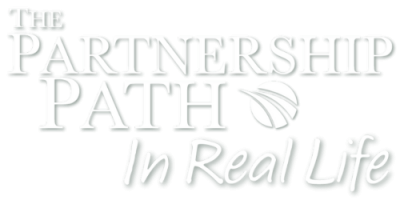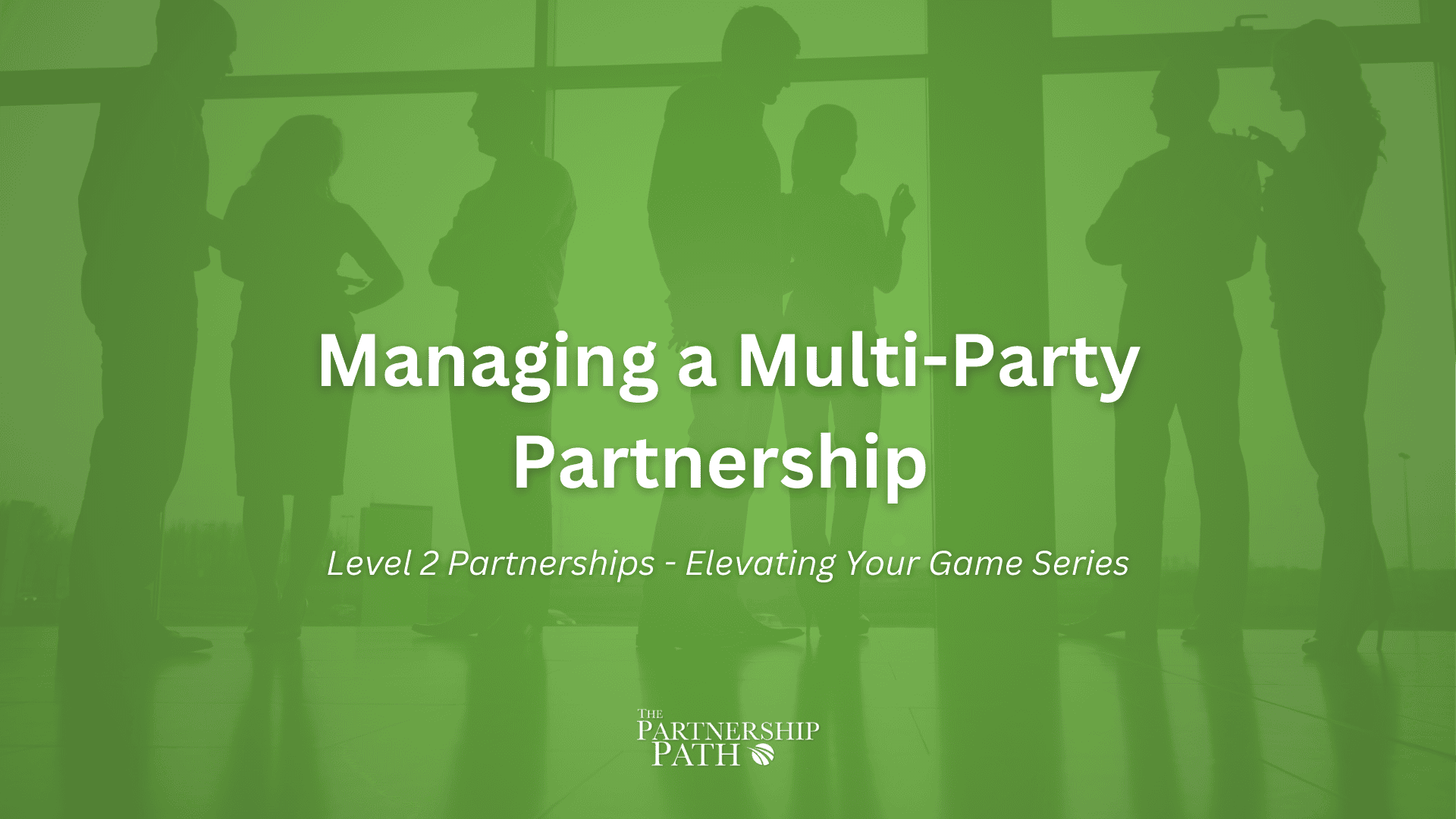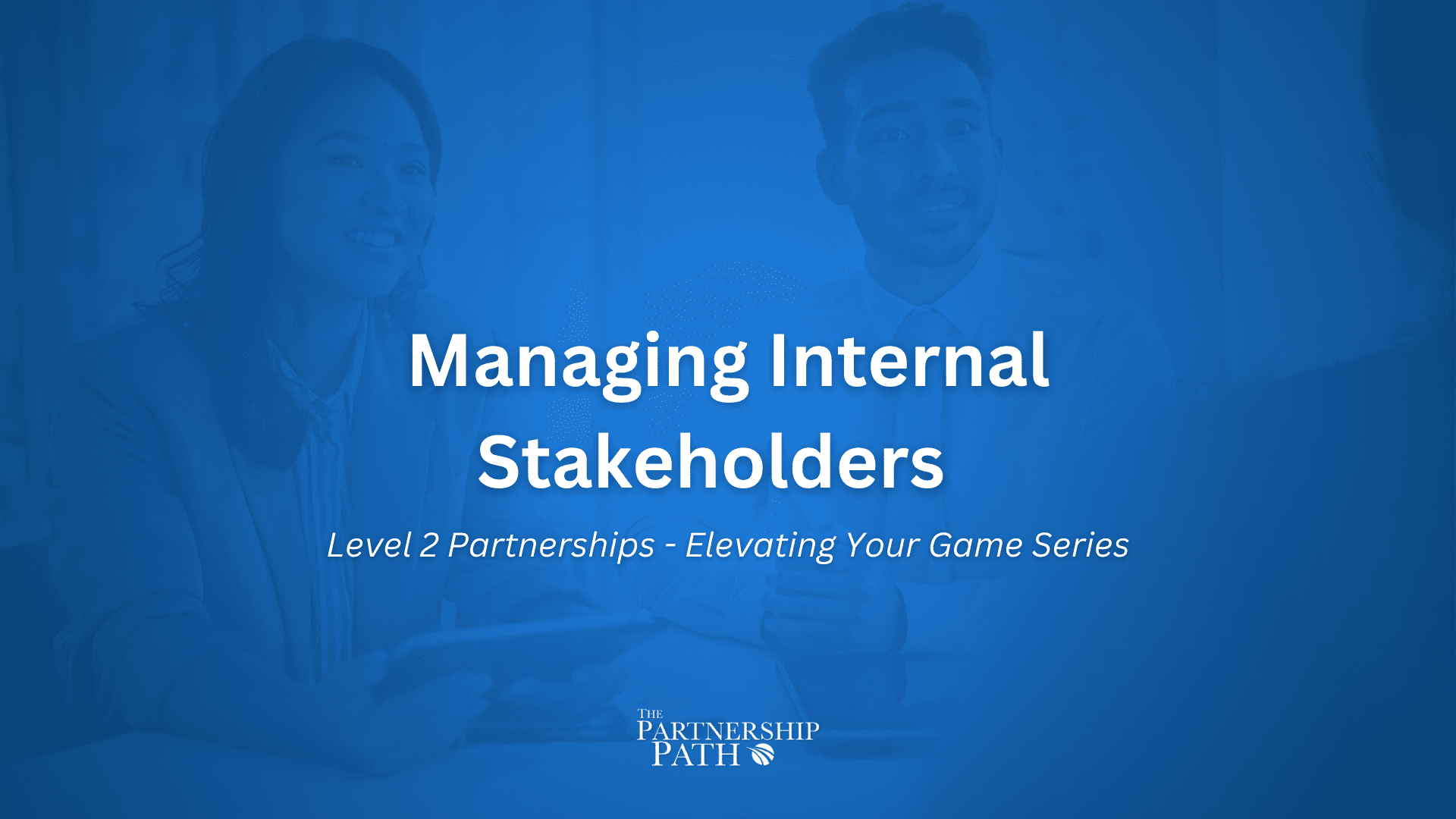IRL Episode
Managing Multi-Party Partnerships with Brad Orluk at Salesforce
Episode Summary
In this episode of The Partnership Path in Real Life, host John Rudow chats with Brad Orluk, Microsoft Alliances Director at Salesforce, about the very real—and very messy—challenges of multi-party partnerships. Their conversation is part war story, part masterclass, and 100% relevant for partner pros trying to scale collaborative go-to-market strategy.
Brad doesn’t sugarcoat it—he gives a pragmatic view of what it takes to make multi-party motions work, especially when direct sales, SIs, hyperscalers, and marketplaces all come to the table.
It’s one thing to align with a single partner. It’s an entirely different beast to align with three, five, or even seven parties—all with their own goals, teams, and agendas. But when you get it right, the impact on your go-to-market strategy can be massive.
Transcript
John (00:01)
Well, hey everybody and welcome to another episode of the Partnership Path in Real Life. I am super excited to have somebody that I barely know on the show today. This is Bradley Orleck. I can’t wait to talk a little bit with Brad about multi-party partnerships. But before I do, let me let Brad introduce himself to everybody. Tell us a little bit about who you are and how long you’ve been working with partners.
Brad (00:23)
gosh, John, I would say first of all, thank you so much for having me. Great to be an acquaintance of yours now for just a short amount of time. The show is fantastic. Absolutely love it. I’m Brad Orlock. I’m the Microsoft Alliances guy, oddly enough, at a small boutique shop. I know everyone makes this joke when they start, but I have to do it too. At a boutique CRM known for a company and an AI player known as Salesforce. So I actually…
John (00:50)
Nice.
Brad (00:52)
was brought in just recently through an acquisition of a company called Own Company, where we did basically backup and recovery of software as a service applications. Before that was managing Microsoft over at a little firewall company called Checkpoint. It also was at a company called Nintex that did workflow business process automation and mapping and really kind of have done a lot of different roles. Everything from managing these like hyperscaler, you know, types of partnerships to working with
SIs and disties and even being a little bit of a screwdriver turner as an SE before that. So I’ve done a little bit of everything, even sold some copiers way back in the day. So I’ve carried a bag, I’ve done partnerships and done tech stuff. But I think it gives me a lot of perspective, if nothing else, I think. But thanks for having me.
John (01:32)
There you go.
Yeah.
Yeah, no, for sure. I know
that’s why the first time you and I talked, Brad, I know that’s why we connected so well is that that combination of sales, pre-sales and partner kind of all wrapped into one package is super powerful, especially in the partnership world, right? To bring that stuff to the partnership world is huge. And of course, you’ve worked at these many of these little boutique companies.
And I want to say that I’m old enough to actually remember when Salesforce was a boutique provider. you know, I’m one of the old guys out here, one of the OGs in that space.
Brad (02:17)
Did they actually come
on a CD at one point too before it became a set? No.
John (02:22)
Yeah, that would make it really a floppy, a floppy disk, right? Yeah. All
right. Well, listen, we’re here today to talk about multi-party partnerships. I know you listened to the episode that Tony and I just did talking a little bit about sort of how that works in theory and some of the challenges we know that people have. Let me just open it up to start with by saying, like, what resonated for you out of that episode or what struck you or what parts of it do you think, man, they got it all wrong there.
You know, give us your thoughts on that episode and let’s go from there.
Brad (02:56)
Well, I would say the first thing that grabbed my attention and shocked me was the idea of seven different partners. was thinking like partnering with seven way kind of parlay, that’s a sophisticated kind of motion. But no, I mean, I thought it was great. I think that the more that we talk about partner to partner kind of motions is a near and dear to my heart, but it’s also critical to what the evolution of partnership is. And I think you guys, you and Tony really kind of.
flush that out at least, know, to get started. you know, what is this thing? Like, what’s this unicorn we’re all pursuing in the woods that, you know, of partnerships is all about. And I think that, you know, landing on first the P2P, you know, vernacular, which Microsoft loves, and that’s near and dear to my heart too. I think that what really intrigues me about the idea of partnering with multiple parties to get that
John (03:40)
Yeah, yep.
Brad (03:53)
You know, I mean, when we talk about partnerships, it’s always one plus one equals three and all that. But it’s, it’s really different when you bring in, you know, more than just, you know, one partner, like an ISV and a hyperscaler. When you get somebody who’s actually where the rubber meets the road with the customer, ⁓ I think it is different and it’s more of a one plus one equals four or five even, because you really do get so many more tools in your proverbial belt, or you can give tools.
John (03:57)
Sure.
Brad (04:21)
to your sellers that you just wouldn’t be able to do by yourself. I think it’s huge. think that the industry, and when I say the industry, I’m really talking about software sales, hyperscalers and cloud. The industry is really embracing it, but it’s still, again, elusive in the sense that a lot of people just don’t know how to do it.
John (04:40)
Yeah.
No, and I think it’s hard. Part of the reason that people don’t spend a lot of time thinking about it is because thinking about it is, really hard. It’s hard enough to get just one other partner on the same page and go to market together. Seven, I think, is kind of a panacea. Nobody’s really there yet. But even thinking about three, Salesforce and Microsoft and
Brad (04:47)
⁓ it’s very hard.
John (05:12)
you know, an SI or some other solution provider trying to go to market together. Man, that’s complicated to sit down and get those three people talking about a target market that they can all agree on and then an approach to that target market that we can all agree on and then execute together. Like that’s hard.
Brad (05:35)
Absolutely. I John, would say it’s really about a maturity model and that’s probably the biggest thing that lacks in most alliances functions that I see is most alliances functions are bolted on to, you know, the sales organization to figure out how do we pivot? How do we take the the sales to the next evolution? And it’s usually, we’re direct today. So we need to do something different or, know,
John (05:47)
Right. Right.
Brad (05:58)
that’s either getting those hyperscalers to help us co-sell or being in marketplaces or it’s like, hey, how do we get close to the customer and get baked into proposals by these SIs? So I feel like the maturity model or going into the idea of multiple party selling and partnering, it’s really about thinking what is your maturity model? If you’re an ISV that’s all direct today and
and you want to move forward with that, you can’t just do it all at once. That’s the other thing too, is I feel like we all have talked about this. People bite off way more than they can chew in partnering. They go, let’s solve for all the world’s problems. let’s just maybe make it, getting one leg on at a time in the morning first, and then we’ll worry about world peace. So I would say that’s really critical is just measuring what your expectations are.
John (06:33)
Yep. Yep. Yeah. Yeah.
That’s right. Yeah. Yeah.
Brad (06:54)
And clearly articulating what those are back to the business and all of the relevant stakeholders on both sides. And then moving from there, because then once you go, well, Hey, I’ve, I’ve got a channel built out. You know, I can actually speak to this just really recently kind of going through this exercise is, you know, a direct sales motion with hyperscaler partnerships, helping us evolve, but then going, ⁓ geez, you know, what we really need to do is build a channel out as well.
And so it’s a little bit of the reverse order almost, whereas a start with the channel first, but again, trying to do it in a very methodical kind of way and measuring the results and also not trying to go after everybody too. That’s the other big thing. Again, it goes back to biting off more than you can chew. Don’t do that. Figure out like, really want to partner with this really big guy and these small gals doing this stuff out in the field.
John (07:26)
Yeah.
Yeah.
Brad (07:53)
and then go, how does it all work, you know, in a very broad stroke kind of way. And then you can get down into the nitty gritty of building out the plan of attack. But I think that that’s probably one of the biggest challenges that I see.
John (08:07)
For sure. And Brad, you’re keying in on some of the things that we, like I think we did in season one of the podcast, we did an episode on what we call strategic alignment, right? Which is really about drawing the boundaries of the partnership. Like what is it that we stand for and who are we going after and what are we selling? And I think if you think about that from two partners perspective only.
It’s a Venn diagram, right? So where do we have that overlap? But then when you add in a third party or a fourth party, it’s still a Venn diagram, but the crossover very likely gets smaller and smaller. the ability of the people involved to say, yes, that little bitty circle is what we’re going to focus on is what you’re talking about. Agreeing to look, I’d love to sell all of this other stuff, but
when the four of us are working together, it’s only going to be for this little bitty thing here. That’s then you can actually go to market. But biting off that bigger chunk is when everybody gets disappointed.
Brad (09:16)
Well, and you know what I think too is a big piece of that is a lot of, I always kind of look at it from an ISB perspective, just so I’ve spent so much time over on that side of the house. But I’ve been in, you know, the SI side as well. And, and I feel like everyone tries to, you know, be everything to everyone. And, and I always think that that’s always the wrong way to do it. It’s like, what are the value drivers that we need to identify first? And it’s like, Hey, you know, as an SI, I want to differentiate.
John (09:40)
Yep. Yep.
Brad (09:45)
from all the other SIs and integrators out there. If I’m a disty, I’m evolving, I’m doing all these different things, I’m now doing SI things. I wanna be more than just licensing, And ISVs are like, well, we just wanna maximize how much money we can exit on, so we need to just sell stuff. ARR, we just gotta focus on ARR and selling more stuff and getting more leads. So I feel like, again, it’s really a matter of going, okay.
John (10:04)
Yeah. Right.
Brad (10:13)
And one fault that ISVs have too is the idea of building out so many tools and then trying to sell all the tools in the bag to everybody. So identify a subset, identify an ideal customer and then say, let’s go meet that customer. And it’s also a big give to get to give something to get something. If you want buy-in, know, maybe give up a deal that you’re already working as an ISV to an SI, become friends, get a win on the board and then G.
John (10:21)
Yeah, that’s right.
Yep. Yep.
Brad (10:41)
Success will drive more success. And then we can get MDF and go do events together and demand gen campaigns and all that stuff. I feel like that’s, know, success is the driver that will drive more success down the road.
John (10:47)
Right. Right.
You know, one of the comments you made a little bit earlier too really struck me as something perhaps that I haven’t really thought about it this way before. So, and given your background, I’d love to kind of get your perspective on this. So even in a two-party partnership, when we think about then a third party actually being my direct sales force or the partner’s direct sales force,
We really should be approaching even that as another partner because that seller comes to the table with their own agenda. But to your point, right, of I got to give up something to get something like we’re you know, what am I willing to negotiate? Right. And and of course, sellers are some of the worst at this. Right. Some of the sellers are because they I mean, they’re carrying the bag. They got the number there. They’re very singularly focused. But if.
Like it’s almost like we need to be thinking about even just a two-party partner motion that includes direct sales to be a multi-party partnership. Like if we could think about it that way, it might make us more successful in how we engage salespeople.
Brad (12:04)
I feel like maybe this has been said by too many people over time because it’s all the rage, but the marketplace piece is almost that elusive kind of like third person in a two party motion because it changes the entire dichotomy of a deal in the sense that, well, I was just sewing to the business and doing my thing of getting IT onboard and all that. And then you’re doing just a regular kind co-selling motion with say a Microsoft, but then it’s like, well, wait.
John (12:16)
Yeah.
Brad (12:33)
If we bring the micro, you know, the marketplace in it’s like, well, now it’s procurement is even more involved. And then there’s other constituencies that are, you know, concerned about drawdown and all that stuff on, on commits and all that. So I feel like you’re, you’re spot on. feel like that’s a really good way to kind of break into multi-party is, is to just bring, bring the, the, additional calculus that’s required to do marketplace successfully in a co-selling motion between you and another company. then.
John (12:43)
Yeah.
Yeah. Yeah.
Brad (13:01)
start bringing other partners in. And I would say path to least resistance in my experience, you know, the, the disties, those, you know, I’ve done a couple of things with some folks like insight and, know, like there’s some great people out there who are, you know, plus have great people who were at some of the hyperscalers before who know the programs and inside and out. So it’s like leverage that kind of expertise to help you smoothly navigate the waters of just incorporating it. And then it’s almost going to come along or multi-party will almost come as like a natural motion.
John (13:23)
Right. Right.
Brad (13:31)
versus some like, ⁓ we’re doing something way out of our comfort zone and all of that stuff. So that’s kind of where I think about it. And then, I guess the eventual model to really kind of grow that further is, yeah, get baked into an offer, right? Get baked into an offering that someone in the field is going out and talking to customers about that you’re just part of the solution. I know easier said than done, but it’s like, there’s very organic ways that you could do that.
John (13:53)
That’s right.
Yeah. And I mean, we have to get there, right? I mean, this idea and I’m getting hit with this from all sides right now, from all of my customers, which is, look, the line between direct sales and indirect partner, like that is blurring beyond anyone. What any of us thought would happen 10 years ago. Right. I mean, it is like, I am a big believer that partnering is selling.
Right? That what you’re selling is the partnership, the idea of that, the two of us together are better. Right? So I have to approach that like a sales opportunity. And so you have to be able to sell to partner. But I also think you have to be able to partner to sell. Like sellers today, if they don’t figure out how to let go of a little bit of control, give something to get something like you can’t be successful if you’re not
capable of partnering. It’s becoming this kind of blurred world of go-to-market.
Brad (15:02)
I totally agree with you. would say that two things that that makes me think of would be partnerships as a whole always reminds me of the movie inception, right? You’re planting, you know, an idea way down in somebody’s subconscious and that, you know, through all the levels, it kind of manifests itself. So, so I feel like we’re always doing that. But to the other side of it too is, yeah, we’re all sellers now and we’re all partners. So it’s not just a classic like
John (15:27)
Yeah. Yeah.
Brad (15:31)
Hey, you know, does this thing look nice? So you could take it home. can be used. You know, it’s not just that kind of sales motion anymore. It’s like, I got to build a real case around this. And I have all these people inside the business that I need to partner with them and figure out how they tick and what, you know, they get measured on so that they can evangelize and sell on my behalf. So salespeople, the best salespeople I see are salespeople that leverage all their internal resources like
John (15:37)
Right, right.
That’s right.
Brad (16:00)
alliances, folks, know, SMEs and SEs and all that stuff, marketing, whomever, but also leverage inside of the customer, the relationship building with all of those different constituencies and making them an advocate versus just being an order taker. Because I can tell you which ones are really successful and which ones aren’t. And when it comes to multi-party, sometimes the partner has a better relationship with those people inside that you need to get to. So you got to figure that out.
John (16:08)
That’s right.
Yep. Yep.
Totally. That’s right.
Yeah. Yeah. And
you’re being kind by saying sometimes, I think it’s most of the time, right? There’s somebody who has a better relationship than you do. And the question is, are you building a relationship with that person or not? Yeah. All right. Listen, Brad, you know, we try and keep these to 15 minutes or so. So we’re at the end of our time, but I want to give you one last thing. Is there anything else you want to tell the listening audience? Any?
Brad (16:39)
Absolutely.
John (16:50)
wisdom or any nugget that you’ve got left that you want to make sure people walk away from with this idea of multi-party partnership.
Brad (16:57)
Gosh, I would say, most importantly, keep listening to this podcast, right? John needs you to listen to it because he’s gonna bring great people on to share a lot of insights. But beyond that, get out there, share with other people, go onto LinkedIn. There’s a lot of great groups around partnering. Try and just talk to other people who are doing what we’re doing and try and learn as much as you can. And I know that’s learning is a loaded kind of term to use, but just follow folks on Twitter.
John (17:02)
I appreciate that.
Yeah. Yeah.
Brad (17:27)
I know Jay McBain’s name always comes up and Jay’s awesome. you know, listen to what Jay has to say. He shares tons of great insights, leverage things like IAMCP to network with other people. Just keep wallowing in it. And I think it comes easier, the whole partnering thing. you know.
John (17:36)
Yep. Yep.
Yeah, love that.
In other words, partner. I mean, right? It’s not just your partners that you’re partnering with. It’s all, it’s the community, it’s everything, right? Be a part of it and learn by being a part of all of those motions with other people. Because I know for sure that given what I do for a living, I learn a lot more from people like you, having people like you come on the show than I do by, you know, sitting in my office trying to think of the next best thing, right? I mean, this is…
Brad (17:45)
PARTNER!
John (18:10)
This is a huge part of what we do is just getting new ideas and thinking it through and talking to people and trying it on. So Brad, thank you, thank you, thank you for coming on the show. I really appreciate it. Loved having you here. We’ll look to find another way to bring you back on. And I can’t wait. Can’t wait for our next conversation.
Brad (18:28)
Thank you for having me. I would love to do it again. Thanks, John.
Key Takeaways
- Multi-party partnerships are hard—but scalable.
You can’t force complex motions overnight. Start small, build trust, and expand based on wins. - Don’t underestimate your sellers—they’re partners too.
Aligning your internal sales team is just as critical as aligning external stakeholders. - The future of selling is partnering.
The lines between direct and indirect are blurring. If you can’t partner, you can’t sell.



